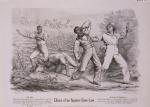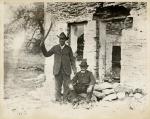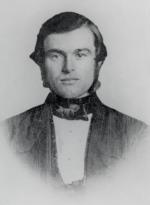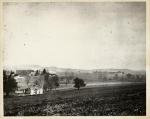![header=[Marker Text] body=[The 1850 federal Fugitive Slave Act strengthened the position of slaveowners seeking to capture runaways. Pursuing four escaped slaves, Maryland farmer Edward Gorsuch arrived Sept. 11, 1851, at the Christiana home of William Parker, an African American who was giving them refuge. Neighbors gathered, fighting ensued, and Gorsuch was killed. This incident did much to polarize the national debate over the slavery issue. ] sign](http://explorepahistory.com/kora/files/1/10/1-A-109-139-ExplorePAHistory-a0a4h6-a_450.gif)
Mouse over for marker text
Name:
The Christiana Riot
Region:
Hershey/Gettysburg/Dutch Country Region
County:
Lancaster
Marker Location:
Lower Valley Rd., South of Christiana, Sadsbury Twp., Lancaster
Dedication Date:
April 25, 1998
Behind the Marker
"Great Riot. Awful Loss of Life in an Attempt to Capture Fugitive Slaves," The Sun, September 9, 1851.
On September 11, 1851, Maryland planter Edward Gorsuch was killed by African Americans in Christiana, Pennsylvania, as he tried to take possession of three young men who had escaped from his ownership two years earlier.
The Christiana " Riot" or "Tragedy," as it became known, ignited a nation increasingly divided over the issue of slavery. Many in the South viewed the failure of the Pennsylvania courts to convict any of the dozens of men who had participated in the riot that resulted in Gorsuch's murder an egregious, willful violation of federal law; a violation that threatened the property rights of Southerners and the stability of the Union. Northern abolitionists, however, viewed it as a victory of liberty against the vile institution of slavery and despicable slave hunters.
One of many acts of self-defense carried out by African Americans, the Christiana riot also symbolized the growing sectional tensions after passage of the Fugitive Slave Act of 1850.
On the morning of November 7, 1849, Edward Gorsuch awoke to discover that four male slaves had fled from his farm in rural Baltimore County, Maryland, the night before. Gorsuch was shocked, for he believed that he had treated the four well and that they respected him.
Influenced by Quakers and the Methodist Episcopal Church, and his decision to grow wheat rather than tobacco, he had already made arrangements to free his slaves once they reached the age of twenty-eight. Just south of the Mason Dixon Line, Maryland was a slave state, but it also was home to the nation's largest population of free African Americans.
Mason Dixon Line, Maryland was a slave state, but it also was home to the nation's largest population of free African Americans.
Despite Gorsuch's promise of manumission, Noah Buley, Nelson Ford, George Hammond, and Joshua Hammond fled in 1849. Nearly a year after their escape, the federal government passed a new law, assisting slave owners like Gorsuch in their search and in the capture of their fugitive slaves.
The Fugitive Slave Act of 1850 made aiding fugitive slaves illegal, punishable by a potential six-month jail sentence and a $1,000 fine. Refusing to help or impeding the capture of a fugitive slave also became a federal offense. The law also denied fugitive slaves the right to a trial by jury. Soon, slave catchers were aggressively pursuing fugitives throughout the North, sometimes kidnapping free African Americans to sell them into slavery in the South.
In August 28, 1851, Gorsuch received the news he had spent two years awaiting: a letter from an informant placed at least three of his slaves in Lancaster County, Pennsylvania. Some 3,000 free African Americans and fugitive slaves lived in Lancaster County, one of the easiest places in the nation for slaves to cross from slavery to freedom. Lancaster had a highly organized underground railroad, with some fifty permanent "stations" scattered across its countryside.
There, two of Gorsuch's escaped slaves were living with a black farmer, William Parker, near Christiana. Parker, too, had run away from Maryland, in 1839, and ran a self-defense group to protect the local community of free blacks from slave catchers. Image 3: Hopkins and Parker, 1896
After obtaining warrants in Philadelphia on September 9, Gorsuch, his son Dickinson, Deputy Marshal Henry H. Kline, and several other men rode west for Christiana. Word of their arrival, however, preceded them, for the Philadelphia Vigilance Committee, run by William Still, sent Samuel Williams, a black man active in the Underground Railroad, to warn Parker and the fugitives of their imminent arrival. Early on September 11, 1851, Gorsuch and his party arrived at the home of William Parker.
William Still, sent Samuel Williams, a black man active in the Underground Railroad, to warn Parker and the fugitives of their imminent arrival. Early on September 11, 1851, Gorsuch and his party arrived at the home of William Parker.
What transpired over the next hours is impossible to know with certainty. What is known is that after Parker's wife Eliza blew a horn out the window of their home to notify the neighbors and members of the self-defense group of the emergence some fifty to one hundred African Americans, armed with guns, pitchforks, and other weapons, ran to the house.
Among the first to arrive was Castner Hanway, a white miller and Parker's closest neighbor, who attempted to calm the mob and warned Gorsuch and Kline to leave before things turned violent.
Gorsuch refused to retreat without his property, the fugitives refused to surrender, and when gunfire broke out Gorsuch fell, mortally wounded, to the ground. As Dickinson ran to help his father, Parker's brother-in-law shot him. Kline and the other members of Gorsuch's party fled, the mob following in hot pursuit. Dickinson would recover from his wounds, but Edward Gorsuch died at Christiana.
Conflicting versions of the riot at Christiana spread like wildfire, igniting passions throughout the country. Some claimed that Dickinson Gorsuch and several African Americans had also been killed, and that women had attacked Gorsuch, "finished him off" with corn-cutters, and then mutilated his body.
In the days that followed, several groups of vigilantes terrorizing African Americans living in Lancaster County in search of participants in the riot. The men of Parker's household, however, had already scattered. Parker and his brother-in-law fled for Canada, traveling through Rochester, New York, where Frederick Douglass helped them obtain passage on a steamer to Toronto.
The law was swift in its response. A grand jury in Lancaster County indicted thirty-eight men on 117 counts of treason–the largest number of Americans ever charged with treason in the history of the United States–including Castner Hanway, whom Deputy Marshal Kline accused of leading the mob and refusing to aid, as required by federal law, in the recapture of escaped slaves.
The ensuing trials attracted national attention. Lucretia Mott and other abolitionists raised money for Hanway's defense, which was led by Pennsylvania Congressman
Lucretia Mott and other abolitionists raised money for Hanway's defense, which was led by Pennsylvania Congressman  Thaddeus Stevens. Hanway's eighteen-day trial, which began on November 24, 1851, was standing room only, the courtroom crowded with reporters, and members of the Society of Friends. Conflicting testimony resulted in the jury finding Hanway not guilty of treason.
Thaddeus Stevens. Hanway's eighteen-day trial, which began on November 24, 1851, was standing room only, the courtroom crowded with reporters, and members of the Society of Friends. Conflicting testimony resulted in the jury finding Hanway not guilty of treason.
The men of Parker's family and Gorsuch's former slaves–those clearly most responsible for the riot-had already escaped to Canada and were thus well beyond the reach of the court. Lacking witnesses who could definitively testify to their guilt, the grand jury also dropped all of the charges against the other men in custody. In the end, the state courts failed to indict anyone for any crimes associated with the Christiana riot.
In its aftermath, however, tensions and violence escalated along the Pennsylvania and Maryland border. Now fueled by the lust for retribution, slave hunters continued their raids and kidnappings. In Maryland, a white man traveling to Baltimore from Lancaster County to petition for the freedom of a free black woman stolen from his farm was killed, allegedly in revenge for the death of Gorsuch.
The Christiana riot and trial also strengthened the convictions of northern abolitionists and inspired others to join the struggle. Castner Hanway became an abolitionist following his trial. Southerners and Northerners in favor of slavery and the rule of law were outraged at the court's failure to win a single conviction.
Three years later, the Pennsylvania Underground Railroad and abolitionist movement would again attract national attention, when the Philadelphia Vigilance Committee aided in the escape of Jane Johnson, as she passed through the City of Brotherly Love, with her owner Colonel John Wheeler, the newly appointed U.S. Minister to Nicaragua.
Jane Johnson, as she passed through the City of Brotherly Love, with her owner Colonel John Wheeler, the newly appointed U.S. Minister to Nicaragua.
"It is an outrage of no ordinary character, and one that has filled our community with a melancholy gloom. The law of the land-the very statute upon which hangs our destiny as a Union-has been wantonly and openly violated..."
"Great Riot. Awful Loss of Life in an Attempt to Capture Fugitive Slaves," The Sun, September 9, 1851.
On September 11, 1851, Maryland planter Edward Gorsuch was killed by African Americans in Christiana, Pennsylvania, as he tried to take possession of three young men who had escaped from his ownership two years earlier.
The Christiana " Riot" or "Tragedy," as it became known, ignited a nation increasingly divided over the issue of slavery. Many in the South viewed the failure of the Pennsylvania courts to convict any of the dozens of men who had participated in the riot that resulted in Gorsuch's murder an egregious, willful violation of federal law; a violation that threatened the property rights of Southerners and the stability of the Union. Northern abolitionists, however, viewed it as a victory of liberty against the vile institution of slavery and despicable slave hunters.
One of many acts of self-defense carried out by African Americans, the Christiana riot also symbolized the growing sectional tensions after passage of the Fugitive Slave Act of 1850.
On the morning of November 7, 1849, Edward Gorsuch awoke to discover that four male slaves had fled from his farm in rural Baltimore County, Maryland, the night before. Gorsuch was shocked, for he believed that he had treated the four well and that they respected him.
Influenced by Quakers and the Methodist Episcopal Church, and his decision to grow wheat rather than tobacco, he had already made arrangements to free his slaves once they reached the age of twenty-eight. Just south of the
Despite Gorsuch's promise of manumission, Noah Buley, Nelson Ford, George Hammond, and Joshua Hammond fled in 1849. Nearly a year after their escape, the federal government passed a new law, assisting slave owners like Gorsuch in their search and in the capture of their fugitive slaves.
The Fugitive Slave Act of 1850 made aiding fugitive slaves illegal, punishable by a potential six-month jail sentence and a $1,000 fine. Refusing to help or impeding the capture of a fugitive slave also became a federal offense. The law also denied fugitive slaves the right to a trial by jury. Soon, slave catchers were aggressively pursuing fugitives throughout the North, sometimes kidnapping free African Americans to sell them into slavery in the South.
In August 28, 1851, Gorsuch received the news he had spent two years awaiting: a letter from an informant placed at least three of his slaves in Lancaster County, Pennsylvania. Some 3,000 free African Americans and fugitive slaves lived in Lancaster County, one of the easiest places in the nation for slaves to cross from slavery to freedom. Lancaster had a highly organized underground railroad, with some fifty permanent "stations" scattered across its countryside.
There, two of Gorsuch's escaped slaves were living with a black farmer, William Parker, near Christiana. Parker, too, had run away from Maryland, in 1839, and ran a self-defense group to protect the local community of free blacks from slave catchers. Image 3: Hopkins and Parker, 1896
After obtaining warrants in Philadelphia on September 9, Gorsuch, his son Dickinson, Deputy Marshal Henry H. Kline, and several other men rode west for Christiana. Word of their arrival, however, preceded them, for the Philadelphia Vigilance Committee, run by
What transpired over the next hours is impossible to know with certainty. What is known is that after Parker's wife Eliza blew a horn out the window of their home to notify the neighbors and members of the self-defense group of the emergence some fifty to one hundred African Americans, armed with guns, pitchforks, and other weapons, ran to the house.
Among the first to arrive was Castner Hanway, a white miller and Parker's closest neighbor, who attempted to calm the mob and warned Gorsuch and Kline to leave before things turned violent.
Gorsuch refused to retreat without his property, the fugitives refused to surrender, and when gunfire broke out Gorsuch fell, mortally wounded, to the ground. As Dickinson ran to help his father, Parker's brother-in-law shot him. Kline and the other members of Gorsuch's party fled, the mob following in hot pursuit. Dickinson would recover from his wounds, but Edward Gorsuch died at Christiana.
Conflicting versions of the riot at Christiana spread like wildfire, igniting passions throughout the country. Some claimed that Dickinson Gorsuch and several African Americans had also been killed, and that women had attacked Gorsuch, "finished him off" with corn-cutters, and then mutilated his body.
In the days that followed, several groups of vigilantes terrorizing African Americans living in Lancaster County in search of participants in the riot. The men of Parker's household, however, had already scattered. Parker and his brother-in-law fled for Canada, traveling through Rochester, New York, where Frederick Douglass helped them obtain passage on a steamer to Toronto.
The law was swift in its response. A grand jury in Lancaster County indicted thirty-eight men on 117 counts of treason–the largest number of Americans ever charged with treason in the history of the United States–including Castner Hanway, whom Deputy Marshal Kline accused of leading the mob and refusing to aid, as required by federal law, in the recapture of escaped slaves.
The ensuing trials attracted national attention.
The men of Parker's family and Gorsuch's former slaves–those clearly most responsible for the riot-had already escaped to Canada and were thus well beyond the reach of the court. Lacking witnesses who could definitively testify to their guilt, the grand jury also dropped all of the charges against the other men in custody. In the end, the state courts failed to indict anyone for any crimes associated with the Christiana riot.
In its aftermath, however, tensions and violence escalated along the Pennsylvania and Maryland border. Now fueled by the lust for retribution, slave hunters continued their raids and kidnappings. In Maryland, a white man traveling to Baltimore from Lancaster County to petition for the freedom of a free black woman stolen from his farm was killed, allegedly in revenge for the death of Gorsuch.
The Christiana riot and trial also strengthened the convictions of northern abolitionists and inspired others to join the struggle. Castner Hanway became an abolitionist following his trial. Southerners and Northerners in favor of slavery and the rule of law were outraged at the court's failure to win a single conviction.
Three years later, the Pennsylvania Underground Railroad and abolitionist movement would again attract national attention, when the Philadelphia Vigilance Committee aided in the escape of











